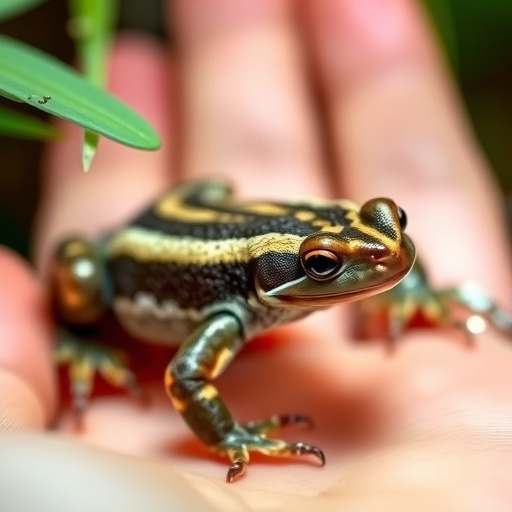
In the vibrant ecosystem of Northeast China, the intricate balance of nature continues to thrive, leading scientists to delve deeper into the biodiversity of the region. Among the many species that inhabit this part of the world, the Northeast China Brown Frog, known scientifically as Rana dybowskii, has garnered attention from researchers interested in its artificial breeding. The quest to understand the potential of this amphibious species is not solely driven by curiosity; it contributes to broader ecological and conservation efforts.
A recent study conducted by Liu, Tao, and Yu has opened avenues for identifying geographical populations that are most suited for artificial breeding initiatives of Rana dybowskii. Such research is crucial in the face of climate change and habitat destruction, which threaten various species, including frogs. The insights gained from this study may be instrumental in developing strategies for preserving this unique species while also addressing the challenges posed by its diminishing habitats.
In recent years, amphibians have faced unprecedented challenges due to environmental changes and human activities. The die-off of amphibian populations around the globe has raised alarms about the health of ecosystems. Recognizing the importance of frogs in controlling insect populations and serving as indicators of environmental health, scientists are stepping up their efforts to ensure the survival of species like the Northeast China Brown Frog.
Liu et al. meticulously examined various geographical populations of Rana dybowskii to identify those with distinctive characteristics suitable for breeding programs. The study employed advanced genetic analysis and ecological assessments to determine the most resilient populations. By understanding the genetic diversity and adaptability of these frogs, researchers aim to bolster their chances of thriving in both their natural conditions and artificial habitats.
Interestingly, the selection process included evaluating the frogs’ habitats. The study took into account factors such as climate, ecological composition, and predator-prey dynamics to identify local populations that exhibit superior traits such as growth rates and reproductive success. These traits are pivotal in establishing a robust and self-sustaining breeding program that can ultimately contribute to the conservation of Rana dybowskii.
Moreover, the application of modern technological methods, including geospatial mapping and ecological modeling, enabled researchers to precisely assess the habitats and interactions of different Rana dybowskii populations. By utilizing these advanced techniques, the researchers could visualize patterns that provide insights into how environmental factors influence the survival and adaptability of these amphibians. This multi-faceted approach is poised to redefine conservation strategies for the Northeast China Brown Frog and other amphibious species.
The significance of this research transcends regional boundaries as it lays the groundwork for future studies on other endangered amphibian species worldwide. The methodology developed by Liu and his colleagues can be adapted to study various ecosystems and species that face similar threats. This adaptability highlights the potential for collaborative global efforts in amphibian conservation, fostering a network of scientific inquiry that extends far beyond Northeast China.
Furthermore, the findings of this study may inspire conservationists to advocate for the protection of critical habitats, emphasizing the urgent need for conservation policies that address habitat preservation and restoration. The threat of climate change looms large over ecosystems worldwide; thus, reinforcing the importance of maintaining ecological balance through research-driven initiatives cannot be overstated.
As scientists continue to unlock the secrets of Rana dybowskii and its descendants, the broader implications of such research become evident. The initiative represents a proactive approach to safeguard biodiversity, emphasizing the interconnectedness of species and ecosystems. Every step toward preserving this remarkable amphibian contributes to sustaining the wider natural world, underscoring how human actions can lead to positive change when guided by scientific inquiry.
Ultimately, Liu, Tao, and Yu’s study closes the gap between rigorous scientific research and real-world application in conservation. As more researchers take up the challenge of studying amphibians, humanity’s responsibility to protect the environment remains paramount. The story of the Northeast China Brown Frog serves as a reminder of the fragility of our planet’s ecosystems and the role we can play in ensuring their continued existence.
In conclusion, Rana dybowskii stands at the crossroads of ecological preservation and human innovation. By understanding its geographical population dynamics, we empower ourselves with vital knowledge that can be harnessed to implement effective breeding programs, ultimately contributing to the survival of an enchanting species poised delicately within the tapestry of nature.
In presenting this research, Liu et al. have illuminated the path forward, showcasing how interdisciplinary approaches are crucial for addressing modern ecological challenges. It is through such comprehensive studies that we can hope to instigate lasting change and cultivate a deeper appreciation for the wildlife that enriches our world.
The study highlights the importance of not only preserving but actively enhancing the environments in which these frogs live. As the scientific community presses forward, it is essential to maintain a dialogue about the importance of biodiversity and the intricate roles species like the Northeast China Brown Frog play in our ecosystems. In this life-affirming endeavor, there lies a potent hope for the future of our planet’s ecological integrity.
Subject of Research: The artificial breeding and geographical population selection of the Northeast China Brown Frog (Rana dybowskii).
Article Title: Selection of geographical populations suitable for artificial breeding of the Northeast China Brown Frog (Rana dybowskii).
Article References: Liu, W., Tao, J., Yu, Q. et al. Selection of geographical populations suitable for artificial breeding of the Northeast China Brown Frog (Rana dybowskii). Sci Nat 112, 66 (2025). https://doi.org/10.1007/s00114-025-02018-7
Image Credits: AI Generated
DOI: https://doi.org/10.1007/s00114-025-02018-7
Keywords: Northeast China Brown Frog, Rana dybowskii, artificial breeding, conservation, biodiversity, ecological assessment, geographical populations, genetic diversity, habitat preservation, climate change, species survival, amphibian research.
Tags: amphibian population studiesamphibian species threatsartificial breeding techniques for frogsbiodiversity in Northeast Chinaecological balance in Northeast Chinaenvironmental health indicatorsimpacts of climate change on amphibiansimportance of frogs in ecosystemsNortheast China Brown Frog conservationpreserving frog habitatsRana dybowskii breeding programsstrategies for frog population preservation




